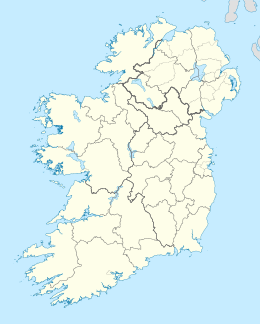Haulbowline
| Native name: Inis Sionnach | |
|---|---|

Aerial view with Naval Base to west (right), industrial site to east (left) & dockyard (centre)
|
|
| Geography | |
| Location | County Cork, Ireland |
| Coordinates | 51°50.5′N 8°18′W / 51.8417°N 8.300°W |
| Area | 35 ha (86 acres) |
| Administration | |
| Province | Munster |
| County | Cork |
| Water body | Cork Harbour |
Haulbowline (Irish: Inis Sionnach), is the name of an island in Cork Harbour off the coast of Ireland. The world's first yacht club was founded in Haulbowline in 1720. The western side of the island is the main naval base and headquarters for the Irish Naval Service, with the eastern side previously used for heavy industry. Since 1966 the island has been connected to the mainland by roadbridge.
The island's name may derive from Old Norse ál-boling or similar = "eel dwelling" ("area where there are conger eels"). The 17th and 18th-century spellings end in "-ing"; there may have been nautical influence on the spelling later. The Irish language name for the island, Inis Sionnach, translates to "island of the fox".
At a strategic and deepwater position in the harbour, the island has long been a military base. The island was first fortified in 1602, and initially an important base for the British Army. In 1603 the Cork city fathers were accused of attempting to demolish it, and William Meade, the Recorder of Cork, was charged with treason as a result. In 1806, the British Army moved to nearby Spike Island, and the fortifications were handed over, with 14 acres (6 ha) of land going to the Royal Navy, and the remaining 8 acres (3 ha) to the Board of Ordnance. (At the time the island was less than half its present size.)
An Ordnance Yard was established on the westernmost part of the island, separated from the rest by a large stone wall. A Martello tower was built for defence, and in 1808 a pair of magazines were erected on nearby Rocky Island with capacity for 25,000 barrels of gunpowder. East of the wall a Victualling Yard was laid out, and from 1807-1824 a series of buildings were constructed, several of which are still standing. Most prominent are six large Storehouses, three grouped together around a quay on the north side of the island, and three along what was then its eastern edge. Behind these was a large rectangular rainwater tank (which collected fresh water for the ships), on top of which was a quadrangular cooperage complex. To the south were a mast and boat store, at the top of a slipway, and to the west, along the length of the wall, were cottages and houses for the workers and officers of the yard. At this time, some 4 acres (2 ha) was added to the island through land reclamation, the first of several such additions.
...
Wikipedia

